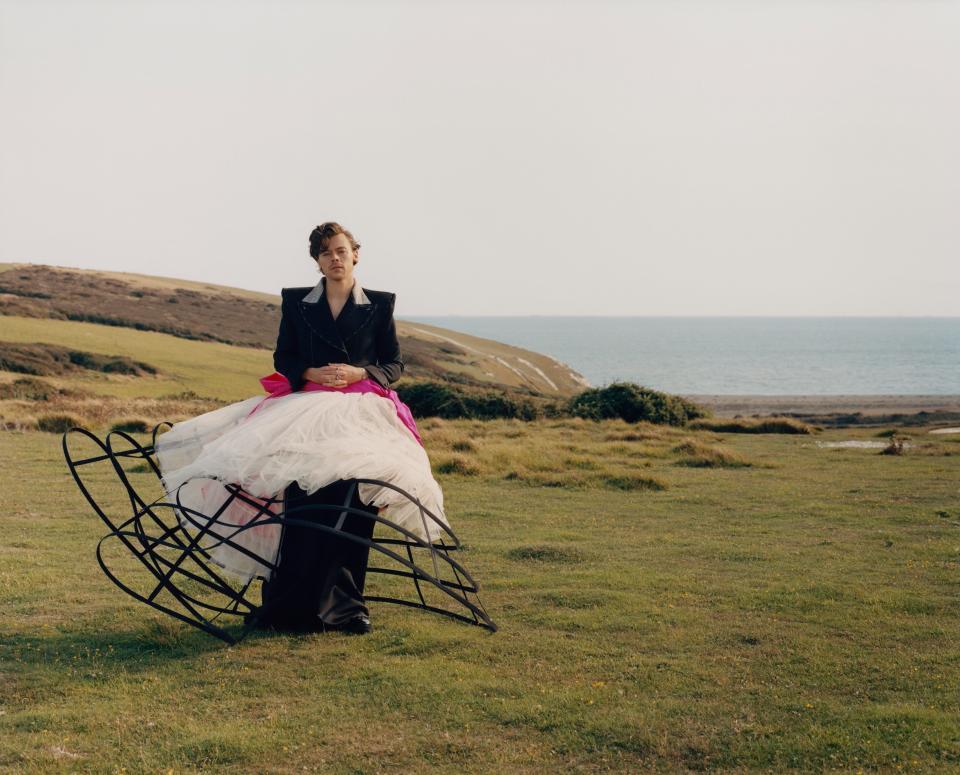Josh Hawley calls for a return to traditional masculinity. A new generation of men disagree.
Missouri Sen. Josh Hawley, a Republican, said Sunday that there was a "crisis of American men," criticizing changing cultural norms for degrading traditional ideas of masculinity. Hawley blames liberals, universities, Hollywood and institutions such as the American Psychological Association, which in 2019 declared aspects of traditional masculinity "harmful."
Hawley's comments come as men on red carpets, on TikTok, and in homes across the country disavow gender norms.
See Harry Styles' Vogue ballgown; Timothée Chalamet's iridescent red carpet looks; and Jaden Smith's gender-fluid fashion. On TikTok, straight young men sport nail polish and talk about vulnerability as a superpower. Transportation Secretary Pete Buttigieg recently defended his right to take paternity leave at a time when polling shows more men see fatherhood as central to their identity. Dwayne Johnson, a former professional wrestler known as The Rock, told Vanity Fair last month that he used to wear a "suit of armor," but to find true intimacy with his wife, he needed to do "a little bit of ripping myself open." He choked up talking about his dad.

People's understanding of gender is always evolving, but experts say several trends are challenging traditional notions of masculinity, which could suggest their power and allure are waning.
"What we may be seeing are examples of policing mechanisms in male peer cultures diminishing in their effectiveness to keep men constrained in these straitjackets of masculine conformity," said Jackson Katz, an expert on masculinity and gender violence. "If that's the case, that's a hugely positive thing, because there are so many negative consequences of forced conformity to rigid ideas of manhood."
Analysis: How men are redefining formalwear
Katz said these changes are not insignificant, but it's also not clear how deep they go. Celebrities are given more license to play with gender and fashion, and even everyday people's social media personas do not always align with their material lives. Rates of male violence, which mental health experts say are driven in part by masculine ideals of dominance and aggression, remain unchanged. And at the same time more men are bucking gender norms, others are digging in.
During the pandemic, job losses and school closures led many fathers to take on more active roles at home. But despite the unprecedented number of men shouldering child care and household responsibilities, most of the extra workload still fell on women.
Coronavirus pandemic: America's first female recession amid child care, unemployment woes
"It's important to keep in mind that unless we're talking about real material differences that actually change the way that power is distributed around gender – like child care arrangements or paternity leave – then some of it is just superficial," Katz said. "Definitions of masculinity may be becoming a little less restrictive in some sense, but then the flip side is you have this incredible backlash movement that's gathering energy all around the country."
'A tremendous amount of growth'
The American Psychological Association defines traditional masculinity as “a particular constellation of standards that have held sway over large segments of the population, including: anti-femininity, achievement, eschewal of the appearance of weakness, and adventure, risk, and violence.” The APA says the pressure boys and men feel to conform to certain aspects of traditional masculinity can lead to poor health outcomes, including higher rates of suicide, substance abuse, violence and early death.
Tony Porter, founder of A Call to Men, a violence prevention organization that focuses on reframing the definition of manhood, particularly in communities of color, said that, historically, men have been socialized to stay within the bounds of what he refers to as the "Man Box." Within it, men are expected to be strong, in control, emotionless. He said that in his 25 years of doing anti-violence work, he has seen masculine norms loosen, with more men feeling comfortable talking about their pain, their fear, their struggles.
"I've seen a tremendous amount of growth," he said. "If we're thinking about the next generation of men and what we're pouring into these boys today, I mean, I may not be here to witness that work, but we do believe that we're going in the right direction," he said.
Katz sees some of the forward momentum made possible by the LGBTQ revolution. The power of homophobia as a policing mechanism is diluted, allowing more men to express themselves in authentic ways, as evidenced by stars like Styles or "Riverdale's" KJ Apa, with his alter ego Fifi.
While it's positive to see straight men embracing feminine expression, some members of the LGBTQ community note that white, heterosexual men, in particular, can co-opt LGBTQ style while maintaining their white privilege. Actor Billy Porter told The Sunday Times last month that, "I feel like the fashion industry has accepted me because they have to. ... I created the conversation (about nonbinary fashion) and yet Vogue still put Harry Styles, a straight white man, in a dress on their cover for the first time."

 Yahoo Autos
Yahoo Autos 